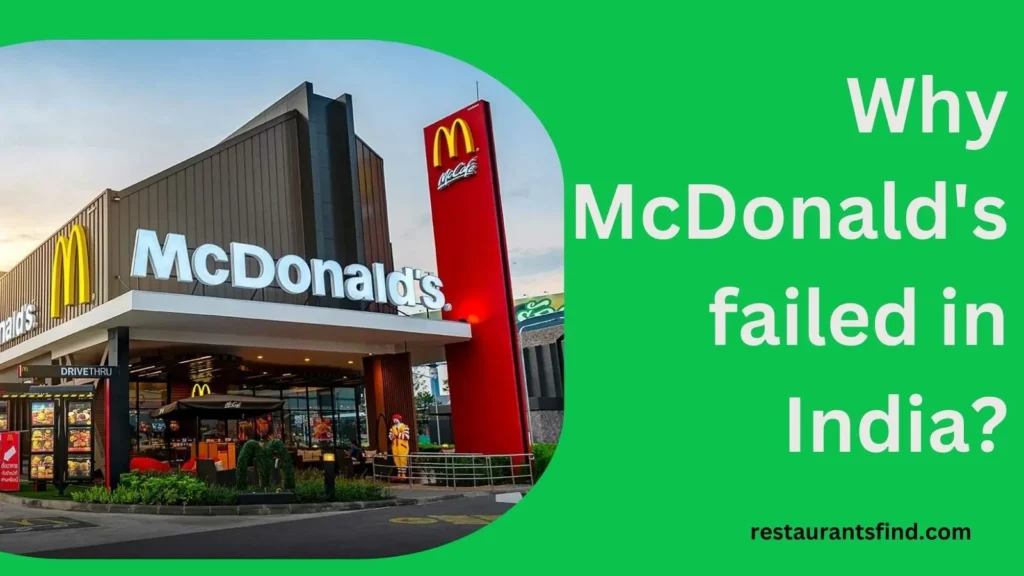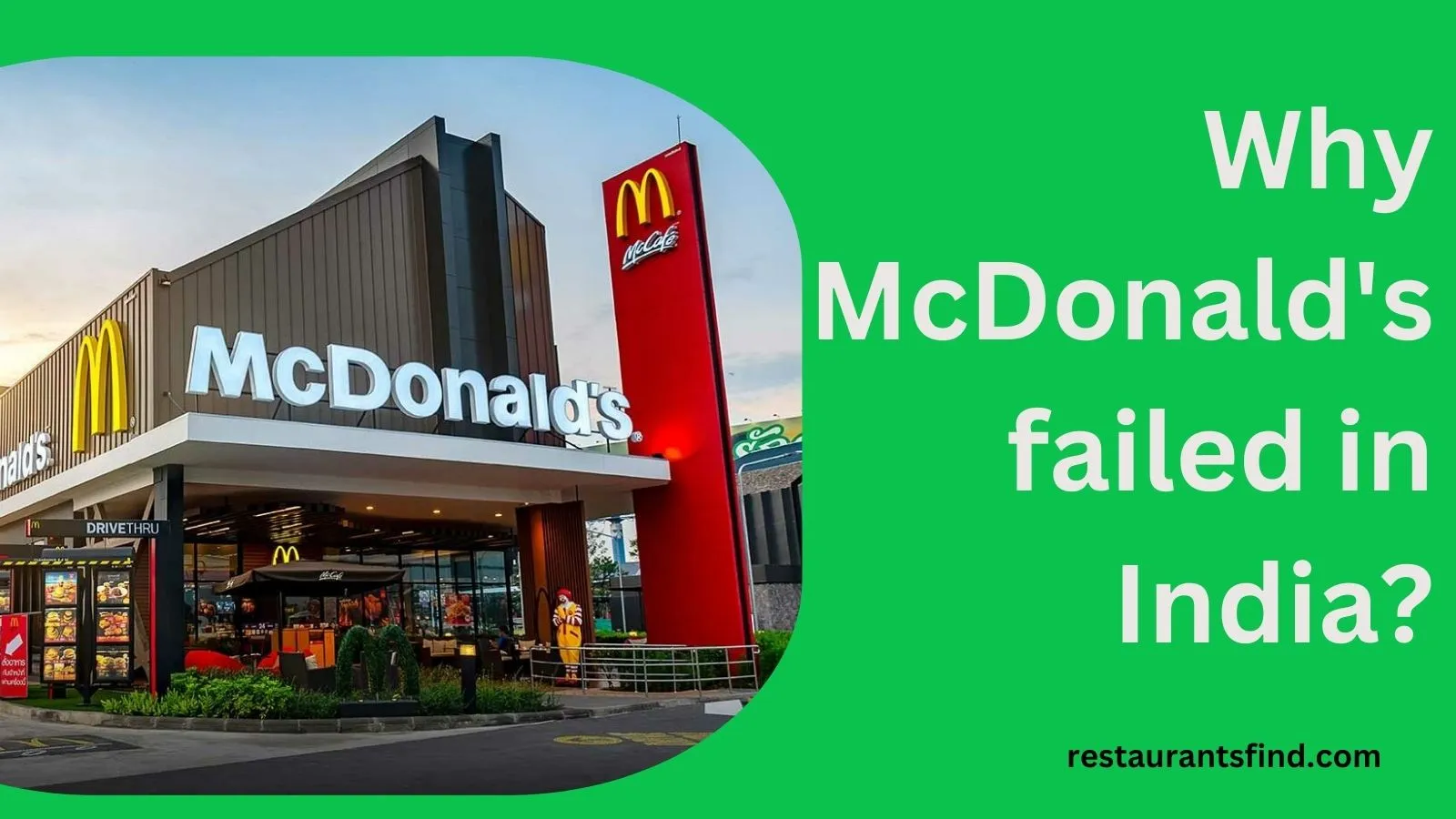McDonald’s is one of the most successful and recognizable fast-food brands in the world, with over 39,000 outlets in more than 100 countries. The company has been able to achieve global success by adapting its menu, marketing, and operations to suit the local preferences and cultures of different markets.
However, not every market has been easy for McDonald’s to crack. One of the most challenging and controversial markets for McDonald’s has been India, where the company has faced several cultural, operational, and regulatory hurdles that have hindered its growth and profitability.
In this blog post, we will examine why McDonald’s failed in India and what lessons can be learned from its experience for other global brands that want to enter or expand in the Indian market.

McDonald’s Entry into the Indian Market
McDonald’s entered the Indian market in 1996, as a joint venture with two local partners: Hardcastle Restaurants Pvt Ltd (HRPL) and Connaught Plaza Restaurants Pvt Ltd (CPRL). The company had to overcome several challenges to establish its presence in India.
Cultural Factors
Dietary preferences
The most significant challenge that McDonald’s faced in India was the dietary preferences of Indian consumers, who are predominantly vegetarian and have religious restrictions on consuming certain foods, such as beef and pork.
To cater to the Indian market, McDonald’s had to eliminate beef and pork from its menu, and introduce vegetarian options, such as the McAloo Tikki burger made of potato and peas. The company also had to segregate its kitchens and utensils to avoid any cross-contamination of vegetarian and non-vegetarian products.
Traditional eating habits
Another challenge that McDonald’s faced in India was the traditional eating habits of the Indian consumers, who prefer local flavors and spices, and value home-cooked meals over fast food.
McDonald’s had to customize its menu and ingredients to suit the Indian palate, such as adding more spices, sauces, and cheese to its burgers and offering regional specialties, such as the Maharaja Mac, a chicken burger with Indian spices.
The company also had to compete with the established local fast-food chains, such as Haldiram’s, Nirula’s, and Jumbo King, which offer similar products at lower prices and have a loyal customer base.
Challenges in Adapting to Local Preferences
Customizing the Menu
Despite McDonald’s earnest attempts to tailor its menu and marketing to local tastes, the company encounters ongoing challenges in engaging and retaining Indian consumers, known for their price sensitivity and relatively low per capita income.
In order to compete with local alternatives like street vendors and dhabas, which offer economical and substantial meals, McDonald’s had to implement a cost-effective strategy.
However, this approach adversely impacted the profitability and quality of McDonald’s offerings, necessitating compromises on portion size, ingredient quality, and service standards.
Managing Price Sensitivity
Another hurdle faced by McDonald’s in India pertained to the intricacies of supply chain management, critical for upholding product quality and consistency. McDonald’s opted to source its ingredients locally to mitigate costs and comply with local regulations, as importing ingredients would be expensive.
However, identifying dependable and high-quality suppliers in India proved challenging, given the country’s fragmented and underdeveloped agricultural sector, coupled with inadequate infrastructure, transportation, and storage facilities.
McDonald’s responded by making substantial investments in developing its proprietary supply chain network and engaging in comprehensive training and monitoring of suppliers to ensure adherence to global standards of quality and hygiene.
Read: Is the restaurant business profitable in India?
Navigating Operational Challenges
Challenges in the Supply Chain
McDonald’s encountered substantial operational hurdles in India, impacting its expansion and overall performance. Central to these challenges was the franchise model embraced by McDonald’s to establish itself in the Indian market.
McDonald’s formed partnerships with two local entities, HRPL and CPRL, granting them exclusive rights to operate outlets in specific regions. However, this model triggered conflicts and disputes between McDonald’s and its partners, as well as disputes between the partners themselves. Issues such as royalty payments, management control, and brand reputation fueled tensions.
The most noteworthy dispute unfolded with CPRL, resulting in the closure of 169 outlets in the northern and eastern regions in 2017. The termination of the franchise agreement led to legal battles, public conflicts, and customer dissatisfaction, tarnishing McDonald’s image in India.
Resolution came in 2019 when McDonald’s acquired CPRL’s stake, establishing a wholly-owned subsidiary, McDonald’s India Pvt Ltd (MIPL), to oversee operations in the northern and eastern regions.
Complexities of the Franchise Model
Another operational challenge for McDonald’s in India revolved around compliance with intricate, inconsistent, and unpredictable local regulations. Securing various licenses and permits from entities such as the Food Safety and Standards Authority of India (FSSAI), the Municipal Corporation of Delhi (MCD), and state governments became a necessity for operating outlets.
However, these processes often faced delays, cancellations, and renewals, disrupting McDonald’s operations and expansion plans. Notable incidents include the temporary closure of 43 Delhi outlets in 2014 due to expired health licenses issued by the MCD.
In 2015, the popular McAloo Tikki burger was recalled and discontinued due to the FSSAI’s ban on potassium bromate, a food additive. Additionally, in 2016, McDonald’s faced a fine of Rs 650,000 for violating the plastic ban imposed by the Maharashtra government.
Marketing and Brand Perception Challenges
Challenges in Image and Perception
McDonald’s encountered formidable hurdles in marketing and establishing its brand in India, a nation with a highly competitive and diverse fast-food industry. The company grappled with image and perception issues, notably the prevalent view of fast food as unhealthy and negative associations with Western brands.
This challenge was exacerbated by the surge of anti-globalization and nationalist sentiments in India. In response, McDonald’s sought to address these concerns through marketing campaigns, prominently featuring slogans like “I’m lovin’ it” and “McDonald’s mein hai kuch baat.” The company endeavored to emphasize quality, hygiene, and social responsibility.
Additionally, McDonald’s aimed to resonate with Indian consumers by spotlighting its local and vegetarian offerings, exemplified by campaigns such as “What’s your veggie?” and “Har cheez mein veggie.”
Despite these efforts, McDonald’s faced persistent negative publicity and criticism from various quarters, including environmentalists, health activists, and religious groups. Accusations ranged from harming the environment to promoting obesity and disrespecting Indian culture and values.
Competition with Local Brands
McDonald’s also confronted intense competition from well-established local brands boasting a robust presence and a loyal customer base in the Indian market.
This competition encompassed local fast-food chains like Haldiram’s, Nirula’s, and Jumbo King, which provided similar products at more affordable prices and with greater variety and customization.
Traditional Indian food outlets, such as chaat, samosa, and dosa stalls, posed further challenges by offering authentic and diverse Indian flavors and cuisines.
McDonald’s struggled to compete with these brands due to their deeper understanding of Indian consumer behavior and preferences, coupled with a more favorable brand perception and reputation in the Indian market.
Regulatory Hurdles
Adherence to Local Regulations
McDonald’s confronted substantial regulatory challenges in India, significantly impacting its operations and expansion efforts. The company had to navigate local regulations’ intricate, inconsistent, and unpredictable landscape.
Compliance required securing various licenses and permits from entities such as the Food Safety and Standards Authority of India (FSSAI), the Municipal Corporation of Delhi (MCD), and state governments to operate outlets.
Unfortunately, these licenses and permits were frequently plagued by delays, cancellations, and renewals, disrupting McDonald’s operations and hindering its expansion plans. Notable instances include the temporary closure of 43 outlets in Delhi in 2014 due to the expiration of health licenses issued by the MCD.
In 2015, McDonald’s faced challenges when it had to recall and cease selling the McAloo Tikki burger, one of its popular products in India, following the FSSAI’s ban on the use of potassium bromate, a food additive. Further complicating matters, in 2016, McDonald’s incurred a fine of Rs 650,000 for violating the plastic ban imposed by the Maharashtra government.
Lessons from McDonald’s Experience in India for Global Brands
McDonald’s encounter in India imparts valuable lessons for global brands eyeing entry or expansion in this market. Some pivotal takeaways include:
- Cultural Sensitivity as a Cornerstone: Emphasize the criticality of cultural sensitivity. Global brands must comprehend and respect the diverse cultural and religious sentiments of Indian consumers. Avoid actions or products that might cause offense or alienation. Adapt menu offerings, marketing strategies, and operations to align with local preferences, steering clear of imposing foreign standards or values.
- Menu and Marketing Customization: Prioritize customization and adaptation in both menu and marketing strategies. Global brands should offer a diverse array of vegetarian and non-vegetarian options, incorporating local flavors and ingredients. Tailor approaches to suit regional and seasonal variations. Communicate the brand’s value proposition and differentiators to Indian consumers, highlighting aspects such as quality, hygiene, and social responsibility. Use local languages, celebrities, and media channels for effective communication.
- Collaborative Partnerships with Locals: Advocate for collaboration with local partners possessing expertise, experience, and a robust network within the Indian market. Such partnerships can aid in navigating the intricate regulatory and business landscape. Maintain transparent and healthy relationships with local partners, striking a balance between global standards and local adaptations.
- Strategic Pricing and Positioning: Adopt a strategic approach to pricing and positioning. Global brands should carefully consider the affordability and perceived value for Indian consumers. Compare offerings with local alternatives, segment and target potential customers based on income, lifestyle, and preferences. Provide diverse options and benefits aligned with the varied needs of the consumer base.
Conclusion
McDonald’s failure in India is a case study of global brands’ cultural and operational challenges in entering and expanding in the Indian market. McDonald’s faced several hurdles in adapting its menu, marketing, and operations to the Indian culture and taste, competing with the established local brands, and complying with local regulations.
McDonald’s also faced several disputes and conflicts with its regional partners, which affected its image and credibility in India. McDonald’s experience in India teaches us the importance of understanding and respecting the local markets and consumers and customizing and adapting our products and services to suit their needs and preferences.
It also teaches us the importance of collaborating with local partners and adopting a strategic approach to pricing and positioning our offerings in the market. By learning from McDonald’s mistakes and successes, we can hope to achieve better results and outcomes in the Indian market and in other emerging and diverse markets around the world.

